碰撞检测的向量实现

27 Jun 2019
Author:wuguanxi
注:1、本文只讨论2d图形碰撞检测。2、本文讨论圆形与圆形,矩形与矩形、圆形与矩形碰撞检测的向量实现
前言
2D游戏中,通常使用矩形、圆形等来代替复杂图形的相交检测。因为这两种形状的碰撞检测速度是最快的。其中矩形包围盒又可以分为轴对齐包围盒(AABB, Axis Aligned Bounding Box)与转向包围盒(OBB, Oriented Bounding Box)。AABB与OBB的区别在于,AABB中的矩形的其中一条边和坐标轴平行,OBB的计算复杂度要高于AABB。根据不同的使用场景,可以用不同的方案。

如上图,明显皮卡超适合用包围盒,精灵球适合用包围球。
向量
向量作为一种数学工具,在碰撞检测中发挥很大作用,后面的计算都是通过向量来完成,所以先来复习一下向量。
向量的代数表示
向量的代数表示指在指定了一个坐标系之后,用一个向量在该坐标系下的坐标来表示该向量,兼具了符号的抽象性和几何形象性,因而具有最高的实用性,被广泛采用于需要定量分析的情形。 对于自由向量,将向量的起点平移到坐标原点后,向量就可以用一个坐标系下的一个点来表示,该点的坐标值即向量的终点坐标。
// 二维平面向量
class Vector2d{
constructor(vx=1,vy=1){
this.vx = vx;
this.vy = vy;
}
}
const vecA = new Vector2d(1,2);
const vecB = new Vector2d(3,1);
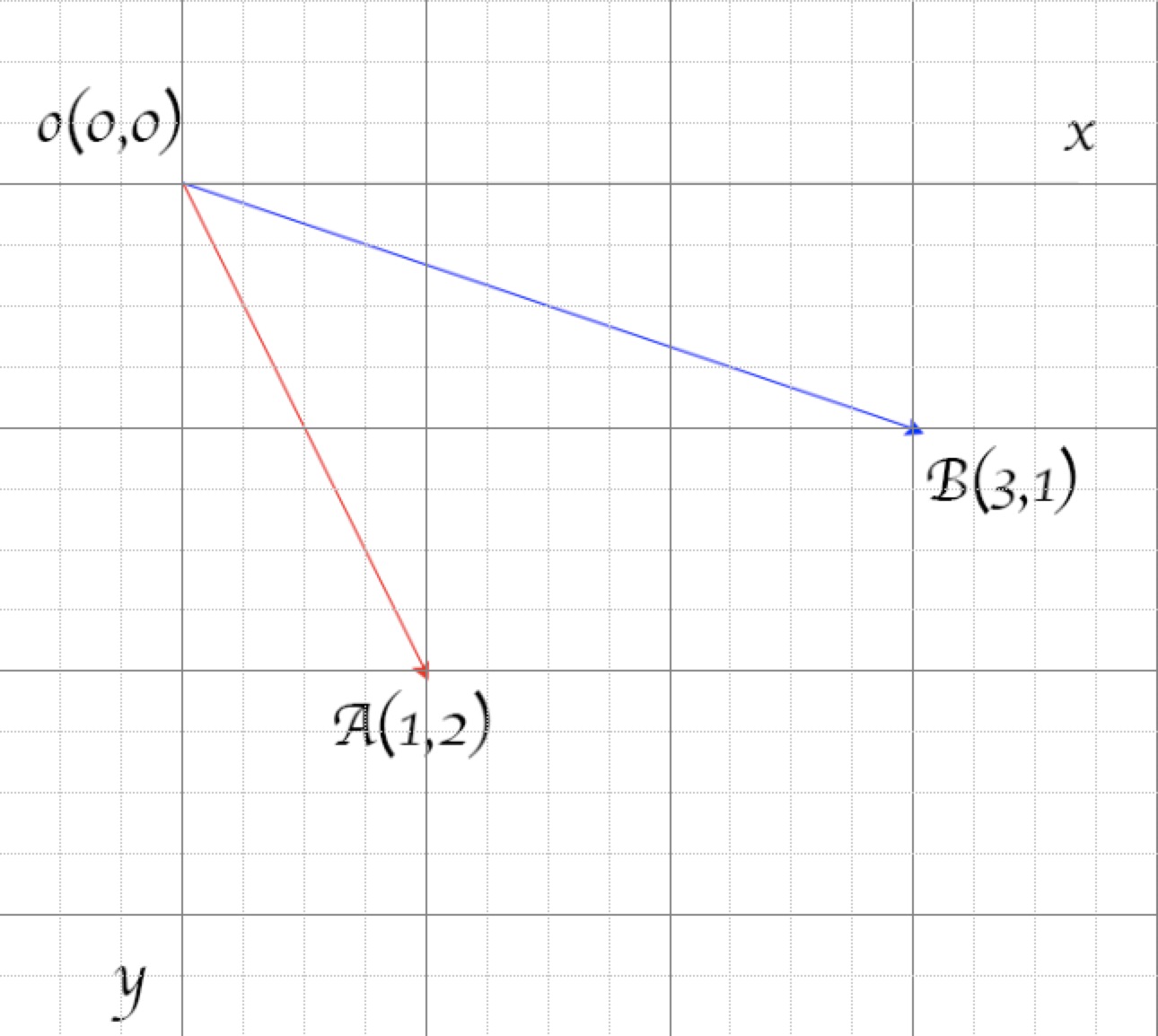
向量运算
加法:向量的加法满足平行四边形法则和三角形法则。具体的,两向量相加还是一个向量,分别是x与y两个分量的相加。
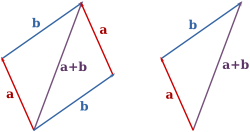
// 向量的加法运算
static add(vec,vec2){
const vx = vec.vx + vec2.vx;
const vy = vec.vy + vec2.vy;
return new Vector2d(vx,vy);
}
减法:两个向量a和b的相减得到的向量可以表示为a和b的起点重合后,从b的终点指向a的终点的向量:

// 向量的减法运算
static sub(vec,vec2){
const vx = vec.vx - vec2.vx;
const vy = vec.vy - vec2.vy;
return new Vector2d(vx,vy);
}
大小:向量的大小,是其各个分量的平方和开方。
// 获取向量长度
length(){
return Math.sqrt(this.vx * this.vx + this.vy * this.vy);
}
点积:从代数角度看,先对两个数字序列中的每组对应元素求积,再对所有积求和,结果即为点积。
// 向量的数量积
static dot(vec,vec2){
return vec.vx * vec2.vx + vec.vy * vec2.vy;
}
旋转:向量的旋转可以用旋转矩阵求解
//向量的旋转
static rotate(vec,angle){
const cosVal = Math.cos(angle);
const sinVal = Math.sin(angle);
const vx = vec.vx * cosVal - vec.vy * sinVal;
const vy = vec.vx * sinVal + vec.vy * cosVal;
return new Vector2d(vx,vy);
}
圆
圆形比较简单,只要确认圆心x,y和半径r就行了,然后推导出圆心向量。
class Circle{
// x,y是圆的圆心 r是半径
constructor(x=0,y=0,r=1){
this.x = x;
this.y = y;
this.r = r;
}
get P(){ return new Vector2d(this.x,this.y) } // 圆心向量
}
矩形
矩形就较为复杂,定义一个矩形需要中心坐标的x,y、两边长w和h,还有根据中心的旋转角度rotation
export class Rect{
// x,y是矩形中心的坐标 w是宽 h是高 rotation是角度单位deg
constructor(x=0,y=0,w=1,h=1,rotation=0){
this.x = x;
this.y = y;
this.w = w;
this.h = h;
this.rotation = rotation;
}
}
两圆相交

两圆相交比较简单,只需判断两圆心之间的距离小于两圆的半径之和。
两圆心距离可以用圆心向量相减,然后求相减向量的长度。
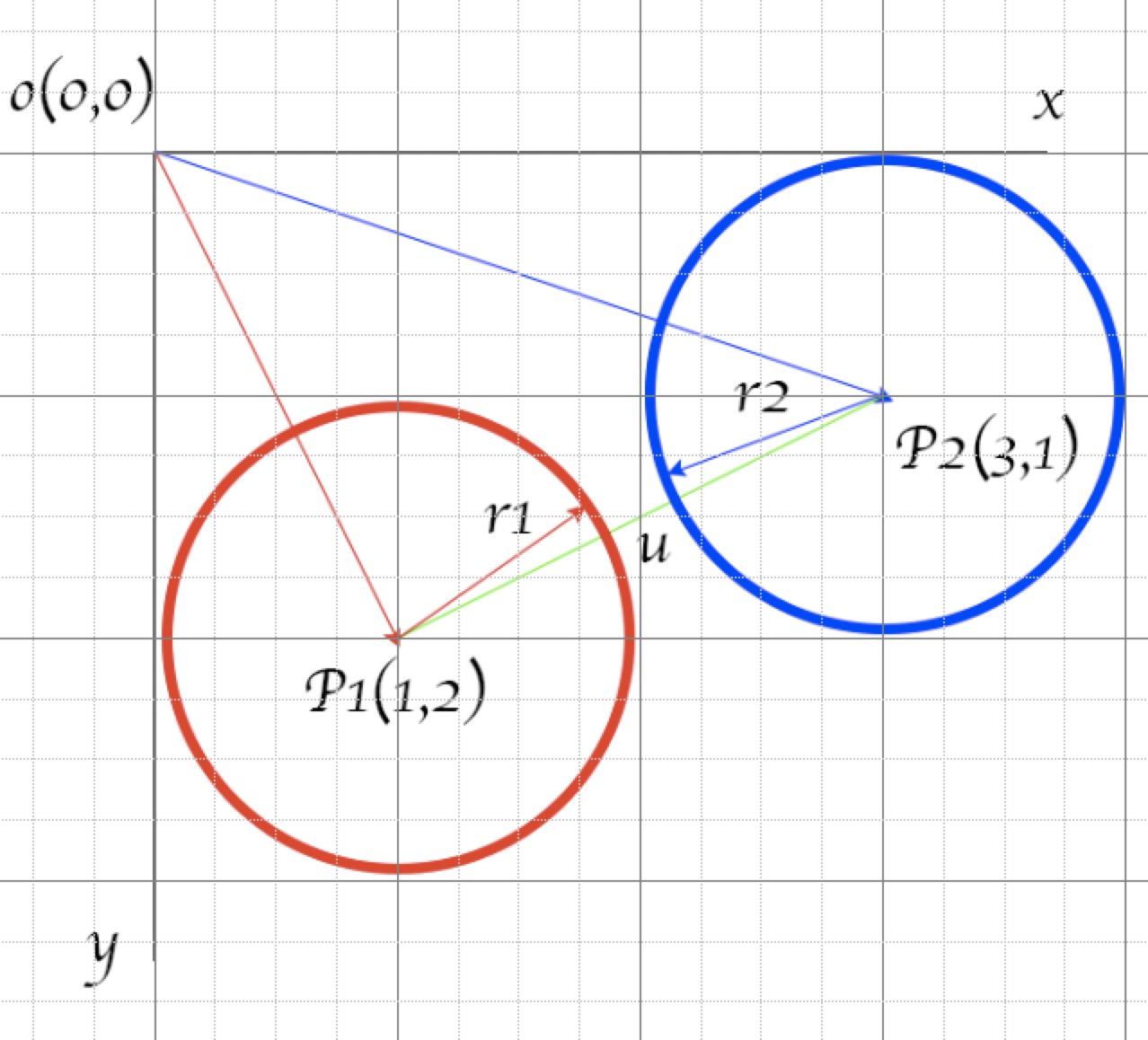
circleCircleIntersect(circle1,circle2){
const P1 = circle1.P;
const P2 = circle2.P;
const r1 = circle1.r;
const r2 = circle2.r;
const u = Vector2d.sub(P1,P2);
return u.length() <= r1 + r2 ;
}
圆和矩形相交
涉及到矩形的相交问题都先要判断是否轴对称。
矩形轴对称
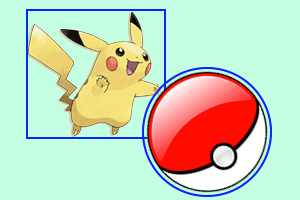
先看轴对称的情况,下面是来自知乎问题怎样判断平面上一个矩形和一个圆形是否有重叠?「Milo Yip」的回答搬运:
设c为矩形中心,h为矩形半長,p为圆心,r为半径。
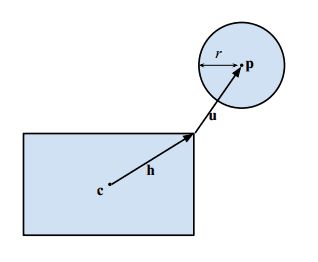
方法是计算圆心与矩形的最短距离 u,若 u 的长度小于 r 则两者相交。
- 首先利用绝对值把 p - c 转移到第一象限,下图显示不同象限的圆心也能映射至第一象限,这不影响相交测试的结果:
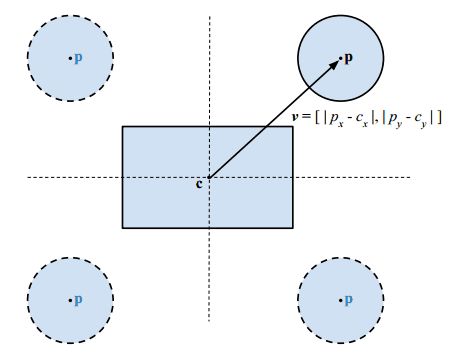
- 然后,把 v 减去 h,负数的分量设置为0,就得到圆心与矩形最短距离的矢量 u。下图展示了4种情况,红色的u是结果。

- 最后要比较 u 和 r 的长度,若距离少于 r,则两者相交。可以只求 u 的长度平方是否小于 r 的平方。
下面我用js实现一下:
其中矩形的四个顶点命名为A1,A2,A3,A4,矩形在第一象限的半長h等于CA3
class Rect{
// x,y是矩形中心的坐标 w是宽 h是高 rotation是角度单位deg
constructor(x=0,y=0,w=1,h=1,rotation=0){
this.x = x;
this.y = y;
this.w = w;
this.h = h;
this.rotation = rotation;
}
get C(){ return new Vector2d(this.x,this.y); } // 矩形中心向量
get A3(){ return new Vector2d(this.x+this.w/2,this.y+this.h/2); } // 顶点A3向量
}
rectCircleIntersect(rect,circle){
const C = rect.C;
const r = circle.r;
const A3 = rect.A3;
const P = circle.P;
const h = Vector2d.sub(A3,C); // 矩形半长
const v = new Vector2d(Math.abs(P.vx - C.vx),Math.abs(P.vy - C.vy));
const u = new Vector2d(Math.max(v.vx - h.vx,0),Math.max(v.vy - h.vy,0));
return u.lengthSquared() <= r * r;
}
矩形非轴对称
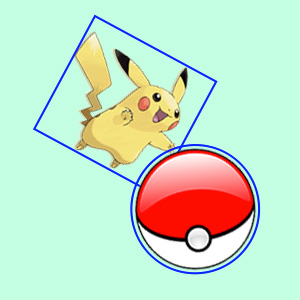
这个问题其实也很好解决,将矩形中心视为旋转中心,将矩形和圆形一起反向旋转将矩形转为轴对称,然后就可以套用上面的解法。

矩形中心到圆心向量为是CP
反向旋转θ度得向量CP'
然后根据向量得三角形定律得OP' = OC + CP'
后面就代入矩形是轴对称的公式进行计算
class Rect{
// x,y是矩形中心的坐标 w是宽 h是高 rotation是角度单位deg
constructor(x=0,y=0,w=1,h=1,rotation=0){
this.x = x;
this.y = y;
this.w = w;
this.h = h;
this.rotation = rotation;
}
get C(){ return new Vector2d(this.x,this.y); } // 矩形中心向量
get A3(){ return new Vector2d(this.x+this.w/2,this.y+this.h/2); } // 顶点A3向量
get _rotation(){ return this.rotation / 180 * Math.PI; } // 角度单位转换
}
p(rect,circle){
const rotation = rect.rotation;
const C = rect.C;
let P;
if (rotation % 360 === 0) {
P = circle.P; // 轴对称直接输出P
} else {
P = Vector2d.add(C,Vector2d.rotate(Vector2d.sub(circle.P,C),rect._rotation*-1)); // 非轴对称,计算P‘
}
return P;
}
rectCircleIntersect(rect,circle){
const rotation = rect.rotation;
const C = rect.C;
const r = circle.r;
const A3 = rect.A3;
const P = p(rect,circle);
const h = Vector2d.sub(A3,C);
const v = new Vector2d(Math.abs(P.vx - C.vx),Math.abs(P.vy - C.vy));
const u = new Vector2d(Math.max(v.vx - h.vx,0),Math.max(v.vy - h.vy,0));
return u.lengthSquared() <= r * r;
}
点击=====> 这里 <=====查看Demo1

两矩形相交
两矩形都轴对称AABB
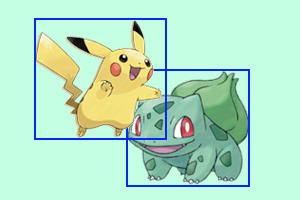
想象一下两个矩形A和B,B贴着A的边走了一圈,B的矩形中心的轨迹是一个新的矩形,这样就简化成新矩形与B中心点这一点的相交问题,又因为点可以看成是半径为0的圆,所以问题又转换为圆形和矩形相交。
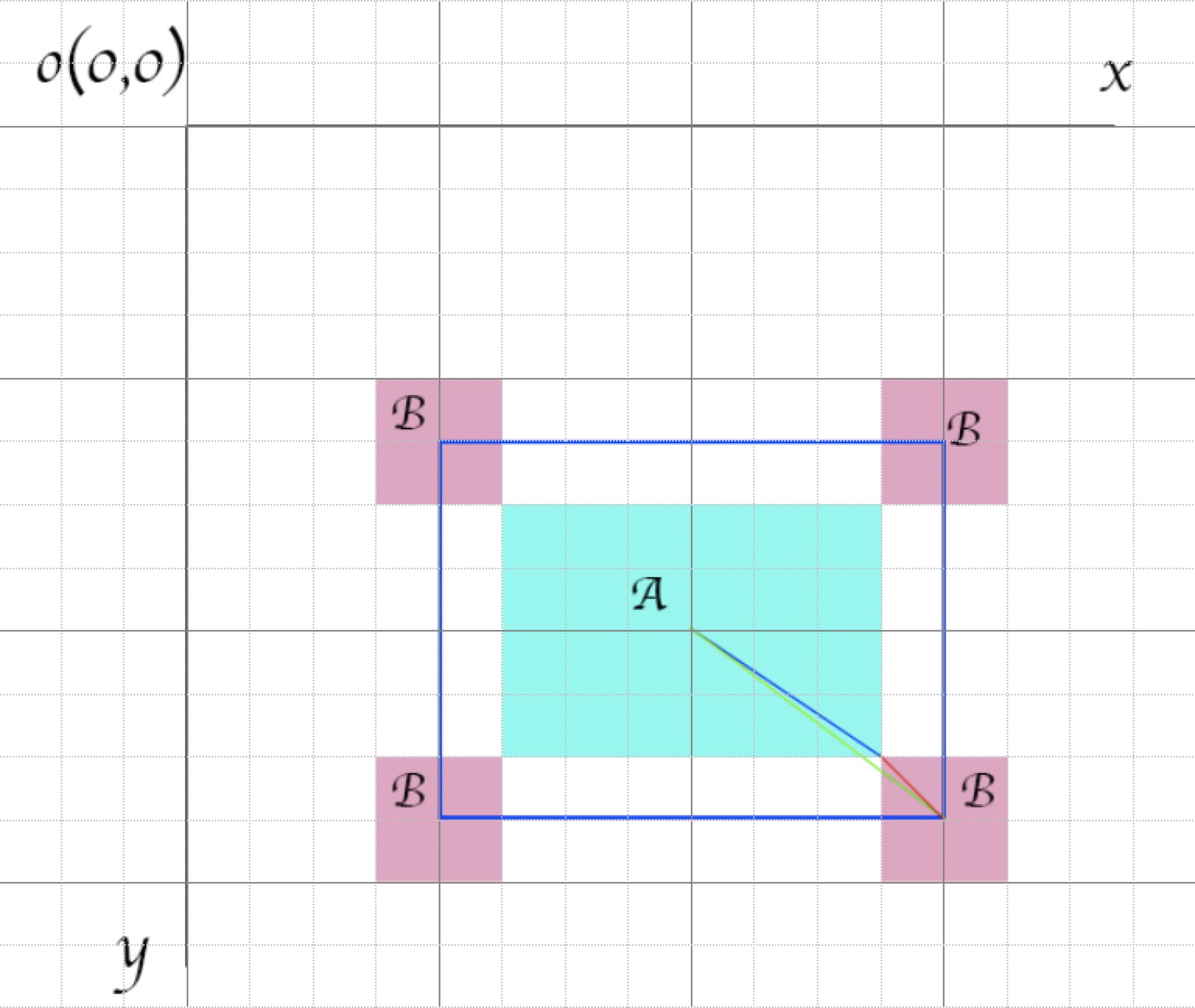
class Rect{
// x,y是矩形中心的坐标 w是宽 h是高 rotation是角度单位deg
constructor(x=0,y=0,w=1,h=1,rotation=0){
this.x = x;
this.y = y;
this.w = w;
this.h = h;
this.rotation = rotation;
}
get C(){ return new Vector2d(this.x,this.y); } // 矩形中心向量
get A3(){ return new Vector2d(this.x+this.w/2,this.y+this.h/2); } // 顶点A3向量
get _rotation(){ return this.rotation / 180 * Math.PI; } // 角度单位转换
}
AABBrectRectIntersect(rect1,rect2){
const P = rect2.C;
const w2 = rect2.w;
const h2 = rect2.h;
const {w,h,x,y} = rect1;
const C = rect1.C;
const A3 = new Vector2d(x+w/2+w2/2,y+h/2+h2/2); // 新矩形的半长
const H = Vector2d.sub(A3,C);
const v = new Vector2d(Math.abs(P.vx - C.vx),Math.abs(P.vy - C.vy));
const u = new Vector2d(Math.max(v.vx - H.vx,0),Math.max(v.vy - H.vy,0));
return u.lengthSquared() === 0; // 点可以看成是半径为0的圆
}
两矩形相交非轴对称OBB
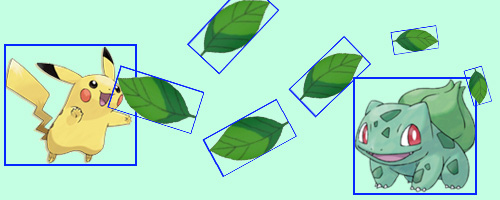
两个矩形的OBB检测使用分离轴定理(Separating Axis Theorem)
分离轴定理:通过判断任意两个矩形 在任意角度下的投影是否均存在重叠,来判断是否发生碰撞。若在某一角度光源下,两物体的投影存在间隙,则为不碰撞,否则为发生碰撞。
因为矩形的对边平行,所以只要判断四条对称轴上的投影即可。
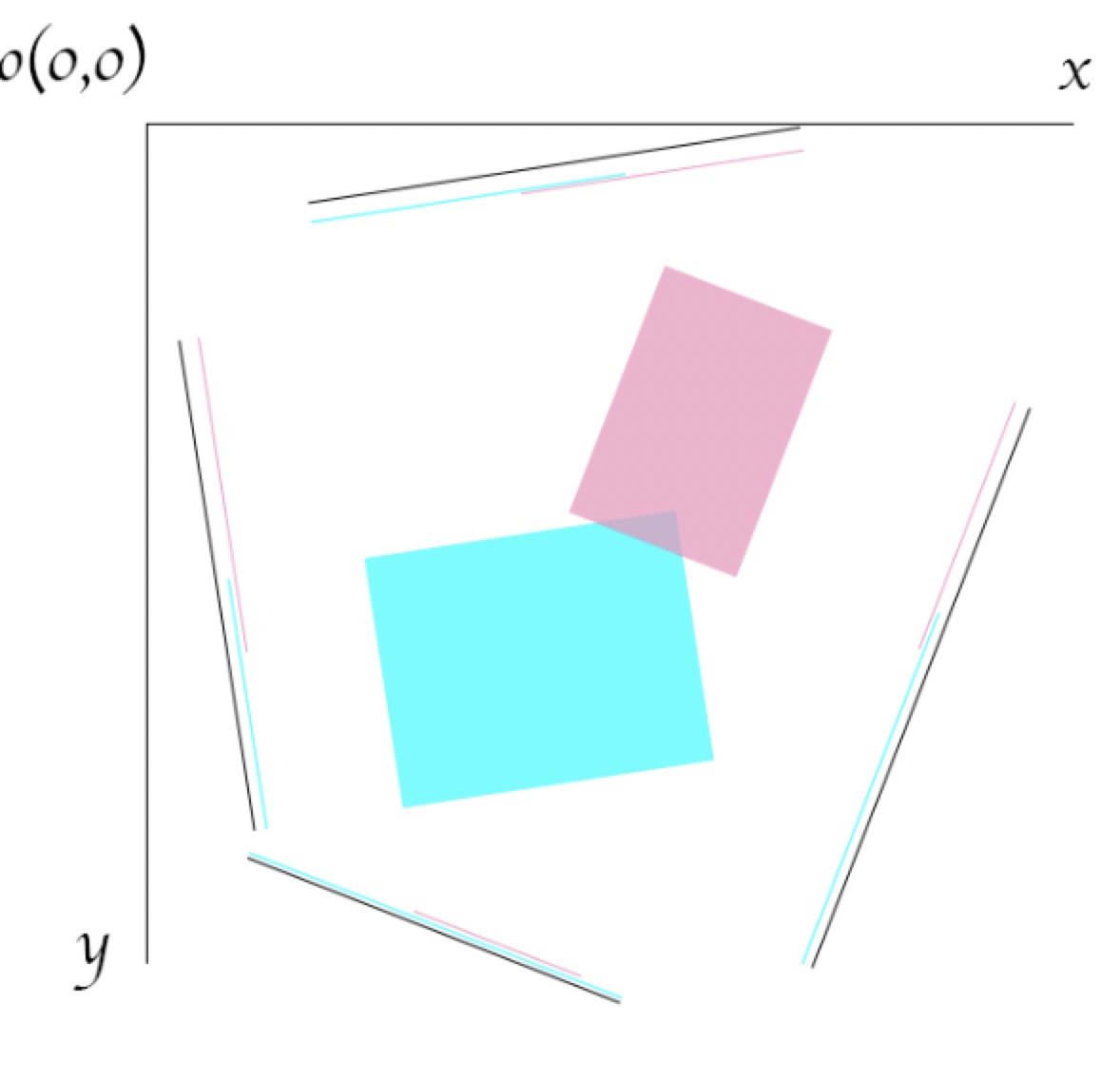
如何投影?这里补充一下向量点积的几何意义。

在欧几里得空间中,点积可以直观地定义为 A·B = |A||B|cosθ ,其中|A|cosθ是A到B的投影,如果B是单位向量,那么A·B就是A到单位向量B的投影
回到矩形,将矩形4个顶点都投影到对称轴上,我们分别将其点乘即可。
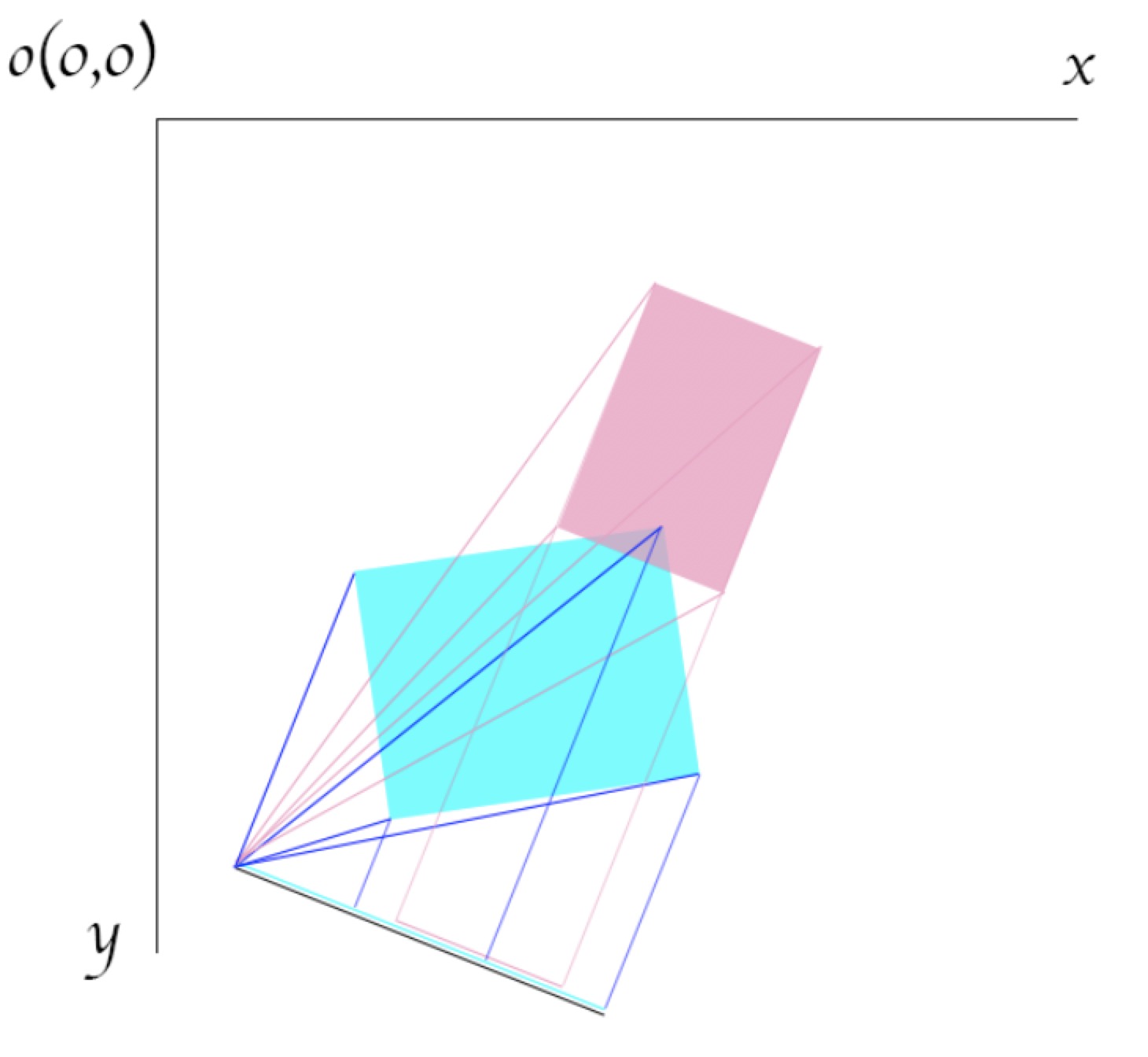
class Rect{
// x,y是矩形中心的坐标 w是宽 h是高 rotation是角度单位deg
constructor(x=0,y=0,w=1,h=1,rotation=0){
this.x = x;
this.y = y;
this.w = w;
this.h = h;
this.rotation = rotation;
}
get C(){ return new Vector2d(this.x,this.y); }
get _A1(){ return new Vector2d(this.x-this.w/2,this.y-this.h/2); } // 4角顶点
get _A2(){ return new Vector2d(this.x+this.w/2,this.y-this.h/2); }
get _A3(){ return new Vector2d(this.x+this.w/2,this.y+this.h/2); }
get _A4(){ return new Vector2d(this.x-this.w/2,this.y+this.h/2); }
get _axisX(){ return new Vector2d(1,0); } // 未旋转时的对称轴X
get _axisY(){ return new Vector2d(0,1); } // 未旋转时的对称轴Y
get _CA1(){ return Vector2d.sub(this._A1,this.C); }
get _CA2(){ return Vector2d.sub(this._A2,this.C); }
get _CA3(){ return Vector2d.sub(this._A3,this.C); }
get _CA4(){ return Vector2d.sub(this._A4,this.C); }
get _rotation(){ return this.rotation / 180 * Math.PI; }
get A1(){ return this.rotation % 360 === 0 ? this._A1 : Vector2d.add(this.C,Vector2d.rotate(this._CA1,this._rotation)); } // 计算上旋转后4角顶点
get A2(){ return this.rotation % 360 === 0 ? this._A2 : Vector2d.add(this.C,Vector2d.rotate(this._CA2,this._rotation)); }
get A3(){ return this.rotation % 360 === 0 ? this._A3 : Vector2d.add(this.C,Vector2d.rotate(this._CA3,this._rotation)); }
get A4(){ return this.rotation % 360 === 0 ? this._A4 : Vector2d.add(this.C,Vector2d.rotate(this._CA4,this._rotation)); }
get axisX(){ return this.rotation % 360 === 0 ? this._axisX : Vector2d.rotate(this._axisX,this._rotation); } // 计算上旋转后的对称轴X
get axisY(){ return this.rotation % 360 === 0 ? this._axisY : Vector2d.rotate(this._axisY,this._rotation); } // 计算上旋转后的对称轴Y
get _vertexs(){ return [this._A1,this._A2,this._A3,this._A4]; }
get vertexs(){ return [this.A1,this.A2,this.A3,this.A4]; } // 4角顶点数组
}
OBBrectRectIntersect(rect1,rect2){
const rect1AxisX = rect1.axisX;
const rect1AxisY = rect1.axisY;
const rect2AxisX = rect2.axisX;
const rect2AxisY = rect2.axisY;
if (!cross(rect1,rect2,rect1AxisX)) return false; // 一旦有不相交的轴就可以return false
if (!cross(rect1,rect2,rect1AxisY)) return false;
if (!cross(rect1,rect2,rect2AxisX)) return false;
if (!cross(rect1,rect2,rect2AxisY)) return false;
return true; // 4轴投影都相交 return true
}
cross(rect1,rect2,axis){
const vertexs1ScalarProjection = rect1.vertexs.map(vex => Vector2d.dot(vex,axis)).sort((a,b)=>a-b); // 矩形1的4个顶点投影并排序
const vertexs2ScalarProjection = rect2.vertexs.map(vex => Vector2d.dot(vex,axis)).sort((a,b)=>a-b); // 矩形2的4个顶点投影并排序
const rect1Min = vertexs1ScalarProjection[0]; // 矩形1最小长度
const rect1Max = vertexs1ScalarProjection[vertexs1ScalarProjection.length - 1]; // 矩形1最大长度
const rect2Min = vertexs2ScalarProjection[0]; // 矩形2最小长度
const rect2Max = vertexs2ScalarProjection[vertexs1ScalarProjection.length - 1]; // 矩形2最大长度
return rect1Max >= rect2Min && rect2Max >= rect1Min; // 相交判断
}
最后放上一个相交的应用Demo,Demo里的形状都可以拖拽,当碰到其他形状时会变透明。



